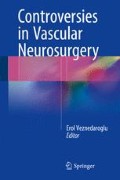Abstract
Rupture of cerebral aneurysms represents an important cause of significant morbidity and mortality. Based on prospective autopsy and angiography studies, 3.6–6 % of the population harbors cerebral aneurysms (Vlak et al., Lancet Neurol 10:626–636, 2011). The most complex of these aneurysms are aneurysms residing within the posterior circulation representing 15 % of all cerebral aneurysms (Spetzler et al., J Neurosurg 123:609–617, 2015). Treatment of cerebral aneurysms is achieved with either endovascular, microsurgical, or hybrid techniques. Given the challenging corridors harboring basilar artery (BA) aneurysms, most aneurysms within this region are treated with endovascular techniques; however, the debate of microsurgical vs. endovascular techniques continues. Both Rangel-Castilla et al. and Rutledge et al. present a great discussion of this debate championing endovascular and microsurgical techniques, respectively. We present the highlights of the previous chapters as well interjecting our own experiences in management of basilar artery aneurysms.
Access this chapter
Tax calculation will be finalised at checkout
Purchases are for personal use only
References
Vlak MH, et al. Prevalence of unruptured intracranial aneurysms, with emphasis on sex, age, comorbidity, country, and time period: a systematic review and meta-analysis. Lancet Neurol. 2011;10(7):626–36.
Spetzler RF, et al. The Barrow Ruptured Aneurysm Trial: 6-year results. J Neurosurg. 2015;123(3):609–17.
Pandey AS, et al. Endovascular coil embolization of ruptured and unruptured posterior circulation aneurysms: review of a 10-year experience. Neurosurgery. 2007;60(4):626–36; discussion 636–7.
Marinkovic SV, Gibo H. The surgical anatomy of the perforating branches of the basilar artery. Neurosurgery. 1993;33(1):80–7.
Murayama Y, et al. Endovascular treatment of incidental cerebral aneurysms. Report on 115 cases treated with guglielmi detachable coils. Interv Neuroradiol. 1999;5 Suppl 1:79–81.
Behme D, Berlis A, Weber W. Woven EndoBridge intrasaccular flow disrupter for the treatment of ruptured and unruptured wide-neck cerebral aneurysms: report of 55 cases. AJNR Am J Neuroradiol. 2015;36(8):1501–6.
Molyneux AJ, et al. International subarachnoid aneurysm trial (ISAT) of neurosurgical clipping versus endovascular coiling in 2143 patients with ruptured intracranial aneurysms: a randomised comparison of effects on survival, dependency, seizures, rebleeding, subgroups, and aneurysm occlusion. Lancet. 2005;366(9488):809–17.
Nanda A, et al. Microsurgical management of basilar artery apex aneurysms: a single surgeon’s experience from Louisiana State University, Shreveport. World Neurosurg. 2014;82(1–2):118–29.
Steinberg GK, Drake CG, Peerless SJ. Deliberate basilar or vertebral artery occlusion in the treatment of intracranial aneurysms. Immediate results and long-term outcome in 201 patients. J Neurosurg. 1993;79(2):161–73.
Hernesniemi J, Korja M. At the apex of cerebrovascular surgery – basilar tip aneurysms. World Neurosurg. 2014;82(1–2):37–9.
Sanai N, et al. The current role of microsurgery for posterior circulation aneurysms: a selective approach in the endovascular era. Neurosurgery. 2008;62(6):1236–49; discussion 1249–53.
Lawton MT. Basilar apex aneurysms: surgical results and perspectives from an initial experience. Neurosurgery. 2002;50(1):1–8; discussion 8–10.
Krisht AF, Kadri PA. Surgical clipping of complex basilar apex aneurysms: a strategy for successful outcome using the pretemporal transzygomatic transcavernous approach. Neurosurgery. 2005;56(2 Suppl):261–73; discussion 261–73.
Krisht AF, et al. Results of microsurgical clipping of 50 high complexity basilar apex aneurysms. Neurosurgery. 2007;60(2):242–50; discussion 250–2.
Drake CG, Peerless SJ, Ferguson GG. Hunterian proximal arterial occlusion for giant aneurysms of the carotid circulation. J Neurosurg. 1994;81(5):656–65.
Peerless SJ, et al. Early surgery for ruptured vertebrobasilar aneurysms. J Neurosurg. 1994;80(4):643–9.
Samson D, Batjer HH, Kopitnik Jr TA. Current results of the surgical management of aneurysms of the basilar apex. Neurosurgery. 1999;44(4):697–702; discussion 702–4.
Brinjikji W, et al. Endovascular treatment of very small (3 mm or smaller) intracranial aneurysms: report of a consecutive series and a meta-analysis. Stroke. 2010;41(1):116–21.
Cruz JP, et al. Pipeline embolization device in aneurysmal subarachnoid hemorrhage. AJNR Am J Neuroradiol. 2013;34(2):271–6.
Wiebers DO, et al. Unruptured intracranial aneurysms: natural history, clinical outcome, and risks of surgical and endovascular treatment. Lancet. 2003;362(9378):103–10.
Killu AM, Lanzino G. Images in clinical medicine: giant basilar-artery aneurysm. N Engl J Med. 2012;367(19):e28.
Alderazi YJ, et al. Flow diverters for intracranial aneurysms. Stroke Res Treat. 2014;2014:415653.
Moon K, et al. Resolution of cranial neuropathies following treatment of intracranial aneurysms with the Pipeline Embolization Device. J Neurosurg. 2014;121(5):1085–92.
Siddiqui AH, et al. Panacea or problem: flow diverters in the treatment of symptomatic large or giant fusiform vertebrobasilar aneurysms. J Neurosurg. 2012;116(6):1258–66.
Ringer AJ, et al. Does angiographic surveillance pose a risk in the management of coiled intracranial aneurysms? A multicenter study of 2243 patients. Neurosurgery. 2008;63(5):845–9; discussion 849.
Ringer AJ, et al. Defining the risk of retreatment for aneurysm recurrence or residual after initial treatment by endovascular coiling: a multicenter study. Neurosurgery. 2009;65(2):311–5; discussion 315.
Zhang X, et al. Factors responsible for poor outcome after intraprocedural rerupture of ruptured intracranial aneurysms: identification of risk factors, prevention and management on 18 cases. Eur J Radiol. 2012;81(1):e77–85.
Hutter BO, Gilsbach JM. Which neuropsychological deficits are hidden behind a good outcome (Glasgow = I) after aneurysmal subarachnoid hemorrhage? Neurosurgery. 1993;33(6):999–1005; discussion 1005–6.
Hutter BO, Gilsbach JM, Kreitschmann I. Quality of life and cognitive deficits after subarachnoid haemorrhage. Br J Neurosurg. 1995;9(4):465–75.
Scott RB, et al. Improved cognitive outcomes with endovascular coiling of ruptured intracranial aneurysms: neuropsychological outcomes from the International Subarachnoid Aneurysm Trial (ISAT). Stroke. 2010;41(8):1743–7.
Pandey AS, et al. High subarachnoid hemorrhage patient volume associated with lower mortality and better outcomes. Neurosurgery. 2015;77(3):462–70.
Author information
Authors and Affiliations
Corresponding author
Editor information
Editors and Affiliations
Rights and permissions
Copyright information
© 2016 Springer International Publishing Switzerland
About this chapter
Cite this chapter
Pandey, A.S., Gemmete, J.J., Chaudhary, N., Thompson, B.G. (2016). Treatment of Basilar Artery Aneurysms: Natural Selection and Propagation of Endovascular Techniques. In: Veznedaroglu, E. (eds) Controversies in Vascular Neurosurgery. Springer, Cham. https://doi.org/10.1007/978-3-319-27315-0_9
Download citation
DOI: https://doi.org/10.1007/978-3-319-27315-0_9
Published:
Publisher Name: Springer, Cham
Print ISBN: 978-3-319-27313-6
Online ISBN: 978-3-319-27315-0
eBook Packages: MedicineMedicine (R0)

